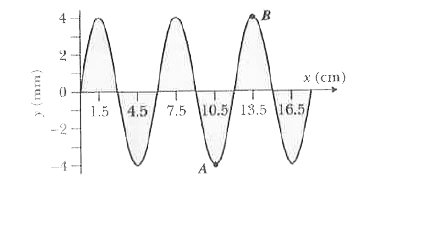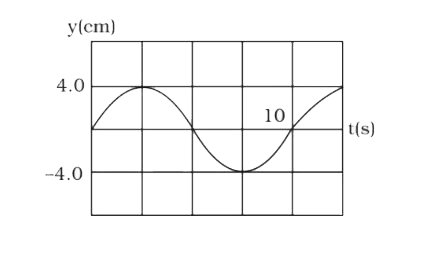Adjacent antinodes of a standing wave on a string are 15.0 cm apart. A particle at an antinode oscillates in simple harmonic motion with amplitude 0.850 cm and period 0.0750 s. The string lies along the +x-axis and is fixed at x=0.
(a) find the displacement of a point on the string as a function of position and time.
(b) Find the speed of propagation of a transverse wave in the string.
(c) Find the amplitude at a point 3.0 cm to the right of an antinode.
The correct Answer is:A, B, C, D
(a) λ2=15cm
∴λ=30cm
k=2πλ=π15cm−1
ω=2πT=2π0.075s−1
Since, x=0 is a node we will write sin
equation.
∴Ax=Amaxsinkx …….(i)
and y=Axsinωt
(b) v=ωk=(2π/0.075)(π/15)
=400cm/s=4m/s.
(c) x=0

x=7.5−3=4.5cm
Form Eq. (i),
Ax=(0.85cm)sin(π15×4.5)
=0.688 cm .
Topper's Solved these Questions
- BOOK - DC PANDEYCHAPTER - SUPERPOSITION OF WAVESEXERCISE - Subjective Questions6videos
SUPERPOSITION OF WAVES
- BOOK - DC PANDEYCHAPTER - SUPERPOSITION OF WAVESEXERCISE - Level 2 Single Correct15videos
SUPERPOSITION OF WAVES
- BOOK - DC PANDEYCHAPTER - SUPERPOSITION OF WAVESEXERCISE - Objective Questions1videos
SUPERPOSITION OF WAVES
- BOOK - DC PANDEYCHAPTER - SOUND WAVESEXERCISE - Exercise 19.74videos
SOUND WAVES
- BOOK - DC PANDEYCHAPTER - THERMOMETRY THERMAL EXPANSION AND KINETIC THEORY OF GASESEXERCISE - Medical entrance gallary30videos
THERMOMETRY THERMAL EXPANSION AND KINETIC THEORY OF GASES
Similar Questions
A body describes simple harmonic motion with an amplitude of 5 cm and a period of 0.2s. Find the acceleration and velocity of the body when the displacement is (a) 5cm, (b) 3cm, (c) 0 cm.
View SolutionA particle of mass 40 g executes a simple harmonic motion of amplitude 2.0 cm. If the time period is 0.20 s, find the total mechanical energy of the system.
View Solution
Knowledge Check
- Question 1 - Select One
A particle executing simple harmonic motion with an amplitude 5 cm and a time period 0.2 s. the velocity and acceleration of the particle when the displacement is 5 cm is
A0.5πms−1,0ms−2B0.5ms−1,−5π2ms−2C0ms−1,−5π2ms−2D0.5πms−1,−0.5π2ms−2 - Question 2 - Select One
A simple pendulum performs simple harmonic motion about x=0 with an amplitude a and time period T speed of the pendulum at x=a/2 will be
Aπa√32TBπaTC3π2aTDπa√3T - Question 3 - Select One
A particle executes simple harmonic motion. The amplitude of vibration of particle is 2 cm. The displacement of particle in one time period is
A1 cmB2 cmC4 cmDzero
A particle executes simple harmonic motion with an amplitude of 10 cm and time period 6s. Ast t=0 it is at position x=5 cm going towasrds positive x-direction. Write the eqwuation for the displacement x at time t. Find the magnitude of the acceleration of the particle at t=4s.
View SolutionA particle executes simple harmonic motion with an amplitude of 10cm and time period 6s. At t=0 it is position x=5cm from mean postion and going towards positive x−direaction. Write the equation for the displacement x at time L. Find the magnitude of the acceleration of the particle at t=4s.
View SolutionA body oscillates with a simple harmonic motion having amplitude 0.05 m. At a certain instant of time, its displacement is 0.01 m and acceleration is 1.0m/s2. The period of oscillation is
View SolutionThe displacement of a vibrating string versus position along the string is shown in the figure. The periodic wave have a speed of 10.0cm/s. A and B are two points on the string.

What is the amplitude of the wave?View SolutionA transverse sinusoidal wave of wavelength 20 cm is moving along a string towards increasing x. the transverse displacement of the string particle at x=0 as a function of time is shown in figure.

Q. The velocity of propagation of the wave is ?View Solution

